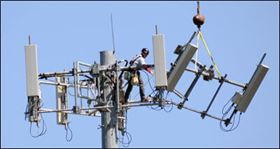Don't Let Dirt on Fiber End-Faces Derail Your Cell Phone Network
Today’s mobile users demand speedy, reliable and omnipresent wireless connections. Fiber is the technology of choice for mobile towers because of the insatiable demand for more and more bandwidth. Thus cell towers that once had three antennas for coverage may have two dozen antennas, and the best technology to move all that data is fiber. This process is generally described as “fiber to the antenna” (FTTA).
This means that “wireless” is not entirely free of wires and cables. The increased demand for cellular bandwidth to support fast growing data usage from smartphones and tablets requires building more towers and upgrading the capacity of the existing ones. More bandwidth means more antennas. More antennas means more cables up the towers. If those cables are coax, it means more weight and wind resistance, perhaps more than the tower was designed for. Lastly, RF (radio frequency) signals require lots of electrical power to transmit their signals since coax cables attenuate the signals at high frequencies.

A worker on a cell phone tower often will need to install, upgrade or repair fiber optic connections even when they are hundreds of feet above the ground. Sticklers™ cleaners can help
In short, your new Samsung or Apple smartphone is totally dependent upon clean, reliable fiber connections coming from towers miles away. Here’s how to keep those customers happy.
Fiber Networks are Fragile
When your business relies on a product about 1/8th the diameter of a human hair, it is understandable that fiber networks are so fragile. The single greatest threat to a fiber signal today is simple contamination on the end-face. Cleaning is not merely important; it is critical to the long-term reliability of any network.
With 5G network technology now here, it is important to ensure that technicians clean the fiber correctly. Each successive generation network needs to handle more data so network reliability is essential to receive seamless connectivity. Deployment of a new 5G network means more data faster, requiring additional fiber to the antenna. To make all this technology work, focus should be on ensuring fiber cleanliness. It must become a “prime directive.”
Contamination is the Enemy
Contamination is the number one enemy of fiber optic connectors because it causes insertion loss and reflectance, and can even damage connectors. Dirty end-faces are very costly because they slow data speeds, frustrate end-users and, worst case, bring a fiber network down.
To prevent contamination from degrading a FTTA network, field technicians must have the right tools to clean every end-face, both sides, every time they are installed, tested or reconfigured, whether at base level or on top of the tower. But there are hundreds of fiber cleaning products on the market — which are the right ones?
What is the Contamination?
End-face contamination includes fingerprint oils, lint, moisture, exhaust fumes, out-gassed plasticizers from protective dust caps, wear debris generated from moving parts when connectors mate, or simply dust. All of these can bring a network to its knees.
There is also contamination from Isopropyl alcohol (IPA). If IPA is the cleaning fluid of choice there is a substantial risk to the network. IPA absorbs moisture from the air (IPA alcohol is “infinitely hygroscopic” and has a strong affinity to water). Instead, choose a cleaning fluid engineered and packaged for working on fiber. That fluid should be ultra-pure, fast-drying and not hygroscopic. It would be even better if the fluid is non-flammable, has a low surface tension, dissipates static and is packaged in a hermetically-sealed container to prevent cross-contamination.
Use a Good Quality Wipe
There is a common misconception that technicians can use any old wipe to help clean their end-faces and splices. Some techs still use their shirts for cleaning — an awful process, if there ever was one. There are enormous differences between different grades of wipes and it is no surprise that better wipes deliver better cleaning. As noted above, better cleaning saves money by enabling the network to run faster, and avoiding expensive repair visits. The best wipes are made from nonwoven fabric, not paper, and do not include cellulose or glues in their construction. These wipes aree substantially stronger and cleaner than cheap wipes (or tee shirts!).
Clean During Connectorization
Another common philosophy is that technicians do not need to concern themselves with cleaning during splicing and connectiorization; after all, the pigtail is coming straight out of the bag. This is not true. When the coating is stripped, the fiber must be cleaned before cleaving to remove any contamination. If this task is not completed it causes a host of problems from pitting and scaring of the end-face to air-gaps between end-faces resulting in back reflection, signal attenuation and instability in the system.
The key points to cleaning fiber correctly are:
- Choose a non-IPA cleaning fluid that is fast-drying, non-flammable, has a low surface tension and dissipates static.
- Use a high-quality, cellulose-free lint-free wipe. Wet-dry cleaning is most effective for removing all forms of contamination and eliminates electrostatic charge.
- If your method of cleaning is with a stick, use one stick per end-face to avoid cross-contamination. Only rotate them in the one direction, usually 4 to 8 rotations is sufficient.
- Don’t use canned air on end-faces; it just pushes the contamination around causing more damage.
- Always clean both ends of a connector pair, and do it just before mating.
- Clean everything even if its straight out a new pack. Clean all equipment including test assemblies, power meters and light sources.
- it is essential to inspect every end-face, both sides, after cleaning.
Cleaning fiber is a necessity and grows even more important as networks become faster and more powerful. Ensure you have the right tools for the job. Remember contamination can be on everything — make the cleaning process a number one priority for all techs, on all connectors, all the time.
